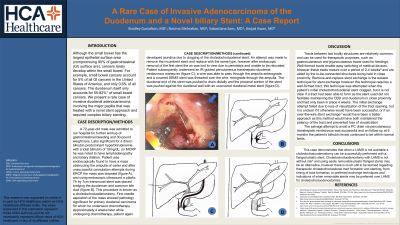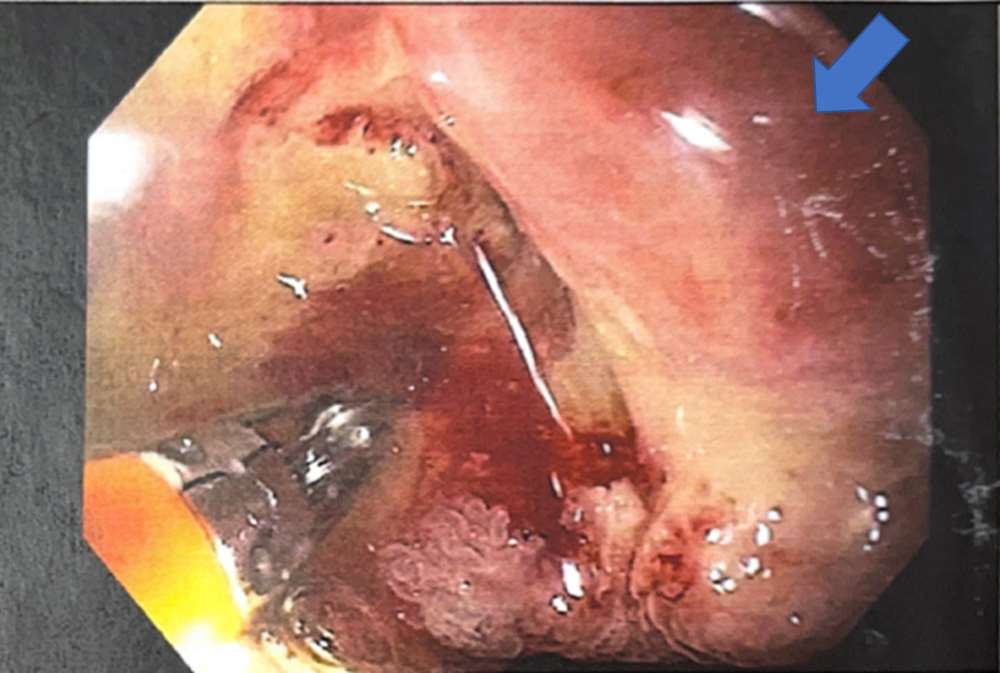Tuesday Poster Session
Category: Biliary/Pancreas
P3602 - A Rare Case of Invasive Adenocarcinoma of the Duodenum and a Novel Biliary Stent: A Case Report
Tuesday, October 29, 2024
10:30 AM - 4:00 PM ET
Location: Exhibit Hall E

Has Audio
- BG
Bradley E. Gustafson, MD
Medical City Arlington
Brainerd, MN
Presenting Author(s)
Bradley E. Gustafson, MD1, Nasima Mehraban, MD2, Sabastiana Sanz, MD2, Amjad Awan, MD3
1Medical City Arlington, Brainerd, MN; 2Medical City Arlington, Denton, TX; 3Medical City Denton, Denton, TX
Introduction: Although the small bowel has the largest epithelial surface area, cancers rarely develop within the small bowel. For example, small bowel cancers account for 2% of all gastrointestinal (GI) cancers in the United States of America, with the majority found in the ileum, followed by the duodenum, and lastly in the jejunum. The duodenum itself only accounts for 0.3% of all gastrointestinal cancers. We present a rare case of invasive adenocarcinoma of the first part of the duodenum and major papilla that required complex biliary stenting.
Case Description/Methods: A 72-year-old male was admitted to our hospital for further workup of gastrointestinal bleeding and 30-pound weight loss. Through imaging it was noted he had lymphadenopathy and biliary dilation. Patient underwent multiple gastrointestinal procedures and was endoscopically found to have a circumferential mass within the ampulla. After unsuccessful cannulation during endoscopic retrograde cholangiopancreatography, a transmural duodenal-common bile duct stent was placed to improve obstruction. Fine needle aspiration of the mass showed pathology significant for primary duodenal carcinoma for which he underwent chemotherapy. While undergoing chemotherapy, it was noted that patient’s original stent was clogged. Patient subsequently underwent complex ampullary stent exchange procedures including a percutaneous transhepatic-transmural duodenal rendezvous maneuver.
Discussion: Diagnosing duodenal cancer is difficult because the presenting symptoms are usually nonspecific and depending on what part of the duodenum is involved, endoscopy screening may not reveal the lesion. Our case demonstrates that choledochoduodenal drainage can be used successfully in duodenal malignancy and is another tool in the endoscopists' arsenal even when the major papilla is “accessible”. While tools like LAMS have been specially designed for opposing lumens, in a pinch a flanged plastic stent can also be used. For cases when it becomes necessary to exchange a CDS one should consider using an exchange technique such as over-the-wire snare-assisted or snare beside-a-wire stent exchange, as the artificial orifice through the duodenal wall appears to close quickly, however further investigation needs to be done. Due to the rarity of duodenal cancers and the complexity of the stenting procedures, our case report will help add to the field to better understand this subject.

Disclosures:
Bradley E. Gustafson, MD1, Nasima Mehraban, MD2, Sabastiana Sanz, MD2, Amjad Awan, MD3. P3602 - A Rare Case of Invasive Adenocarcinoma of the Duodenum and a Novel Biliary Stent: A Case Report, ACG 2024 Annual Scientific Meeting Abstracts. Philadelphia, PA: American College of Gastroenterology.
1Medical City Arlington, Brainerd, MN; 2Medical City Arlington, Denton, TX; 3Medical City Denton, Denton, TX
Introduction: Although the small bowel has the largest epithelial surface area, cancers rarely develop within the small bowel. For example, small bowel cancers account for 2% of all gastrointestinal (GI) cancers in the United States of America, with the majority found in the ileum, followed by the duodenum, and lastly in the jejunum. The duodenum itself only accounts for 0.3% of all gastrointestinal cancers. We present a rare case of invasive adenocarcinoma of the first part of the duodenum and major papilla that required complex biliary stenting.
Case Description/Methods: A 72-year-old male was admitted to our hospital for further workup of gastrointestinal bleeding and 30-pound weight loss. Through imaging it was noted he had lymphadenopathy and biliary dilation. Patient underwent multiple gastrointestinal procedures and was endoscopically found to have a circumferential mass within the ampulla. After unsuccessful cannulation during endoscopic retrograde cholangiopancreatography, a transmural duodenal-common bile duct stent was placed to improve obstruction. Fine needle aspiration of the mass showed pathology significant for primary duodenal carcinoma for which he underwent chemotherapy. While undergoing chemotherapy, it was noted that patient’s original stent was clogged. Patient subsequently underwent complex ampullary stent exchange procedures including a percutaneous transhepatic-transmural duodenal rendezvous maneuver.
Discussion: Diagnosing duodenal cancer is difficult because the presenting symptoms are usually nonspecific and depending on what part of the duodenum is involved, endoscopy screening may not reveal the lesion. Our case demonstrates that choledochoduodenal drainage can be used successfully in duodenal malignancy and is another tool in the endoscopists' arsenal even when the major papilla is “accessible”. While tools like LAMS have been specially designed for opposing lumens, in a pinch a flanged plastic stent can also be used. For cases when it becomes necessary to exchange a CDS one should consider using an exchange technique such as over-the-wire snare-assisted or snare beside-a-wire stent exchange, as the artificial orifice through the duodenal wall appears to close quickly, however further investigation needs to be done. Due to the rarity of duodenal cancers and the complexity of the stenting procedures, our case report will help add to the field to better understand this subject.

Figure: Mass of the duodenal bulb extending to the ampulla of Vater.
Disclosures:
Bradley Gustafson indicated no relevant financial relationships.
Nasima Mehraban indicated no relevant financial relationships.
Sabastiana Sanz indicated no relevant financial relationships.
Amjad Awan indicated no relevant financial relationships.
Bradley E. Gustafson, MD1, Nasima Mehraban, MD2, Sabastiana Sanz, MD2, Amjad Awan, MD3. P3602 - A Rare Case of Invasive Adenocarcinoma of the Duodenum and a Novel Biliary Stent: A Case Report, ACG 2024 Annual Scientific Meeting Abstracts. Philadelphia, PA: American College of Gastroenterology.
